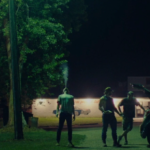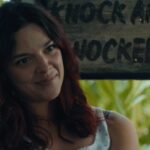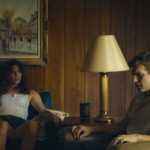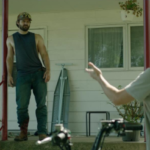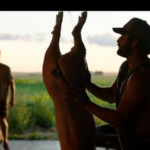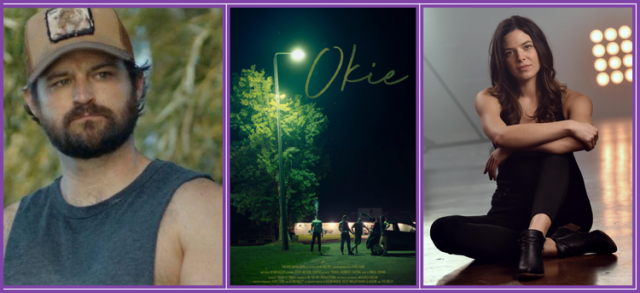
In this fun-filled and interesting exclusive interview director/actor KATE COBB and writer/actor KEVIN BIGLEY do a deep dive into the making of OKIE.
SYNOPSIS: Louie (Scott Michael Foster), a wealthy writer, returns to his beleaguered hometown after his father passes away. The town, a weathered setting, and its people, equally worn, have served as the spiritual muses for Louie’s popular, rustic anthology. Upon his return, Louie is reunited with his childhood friends Travis (Kevin Bigley) and Lainey (Kate Cobb), the very same people he utilized as central characters in his pretentious novels. Thus ensues a confusing swirl of nostalgia and enmity as Louie is dragged from party-to-party, coming face-to-face with those whose lives he’s exploited for his own financial gain. But soon, as his grip on reality slips, he begins to wonder if these ostensibly simple townsfolk don’t have their own version of payback in mind.
Directed by KATE COBB, who makes her feature directorial debut here, with script by KEVIN BIGLEY, Cobb and Bigley also star in OKIE along with Scott Michael Foster, Josef Bette, Dan J. Johnson, and Michael Waller.
Sacrificing part of the day on their 10th anniversary to speak with me about OKIE, you will find yourself not only immediately drawn to their mutual sense of humor and passion for their crafts, but how collaborative and of “one mind” they are with the vision of OKIE. Quite honestly, Kate and Kevin are fantastic fun filmmakers.
Highlighting the film’s development from a proof of concept short to a feature, Kate hones in more on the technical directorial aspects of the film, emphasizing the importance of natural light cinematography and character authenticity, particularly in portraying small-town dynamics. However, Kevin’s role as a writer and Kate’s as a director are intertwined, with their collaboration extending to producing and acting. The film’s visual grammar, including handheld shots and specific lighting choices, enhances the story’s tone. A challenging editing process stemmed from a tight schedule, but the pacing was crucial to convey the passage of time within the story construct, something that required editorial attention.
While Kate and Kevin have each had their individual careers in the business as actors, with Kate also directing and editing some shorts, and Kevin putting pen to paper, both knew they wanted to collaborate on a project together which led them to a proof of concept short that led to OKIE. A wonderful calling card for Kate and Kevin as each wears multiple hats with this production, we broke down all the filmmaking elements in this exclusive conversation,including:
- themes of mental illness and the unreliable narrator
- the use of handheld camerawork and a lack of extensive equipment helped create a sense of unease and loss of control, mirroring the protagonist’s mental state
- compressed time and pacing with a structure aimed to create a feeling of compressed time and a blurring of the passage of days, reflecting the protagonist’s spiraling mental state
- subjective perception of characters
- “hallucinogenic” visual effects; e.g. in the dunk tank sequence, the filmmakers incorporated blurring, twisting, and other hallucinogenic visual effects to further convey the protagonist’s mental instability
- open-ended ending, allowing viewers to interpret the protagonist’s mental state and the reality of the events for themselves
- balancing directing and acting; balancing writing and acting and deferring to the director; for Kate, separating one’s ego as an actor from the needs of the overall project as the director
- importance of pre-production planning and storyboarding to maintain flexibility and efficiency on a tight shooting schedule
- value of building a trusted creative team who can provide valuable feedback
- working with cinematographer Wojciech Kielar and developing visual grammar
- storyboarding every single frame of the film, which allowed them to be more flexible on the day of shooting and make adjustments as needed
- utilization of natural light; experimentation with lighting, e.g. lighting a scene entirely with flashlights which challenged the cinematographer but ultimately served the story
- handheld camerawork, which added to the film’s gritty, emotive feel
- careful framing and composition; visual contrast between the physically imposing Travis and the more vulnerable Louis was intentionally conveyed through the framing and composition of the shots
- editing challenges and working with Joseph Ettinger and Chris Hurte; minimal options for “connective footage” due to tight shooting schedule; finding pace and rhythm
- character development; character traits; dynamics among the “old friends”; creating the “feel” of a rural small town
- and more!
TAKE A LISTEN. . .
by debbie elias, exclusive interview 11/08/2024
OKIE is now available on VOD
.
.


